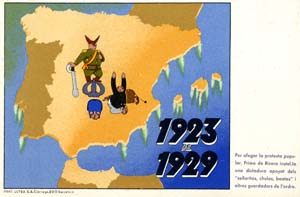1923 AL 1929
Per afegar la protesta popular, Primo de Rivera instal.la una dictadura apoyat dels "señoritos, chulos, beatas" i alters guardadors de l'ordre.
Para acallar la protesta Popular, Primo de Rivera, instala una dictadura, apoyado de los señoritos, chulos y beatas y otros guardadores del orden.
Pour faire taire le peuple qui proteste, Primo de Rivera instaure une dictature avec l'aide de "señoritos", "chulos", et "beatas" et autres défenseurs de l'ordre ("fils à papa" "traîneurs de sabre" et "calotins").
To stifle the people's protests, Primo de Rivera sets up a dictatorship based on petty aristocrats, swindlers, and bigots, as guardians of the public peace.
Por silentigi la popolan protestadon, Primo de Rivera instalas diktaturon apogite de la sinjoridoj, bravulacoj, bigotulinoj kaj aliaj gardantoj de la ordo.
Supported by a large fraction of the Spanish people concerned with the disorder of the previous six years, General Miguel Primo de Rivera organized a pronunciamento (coup d'état) on September 23, 1923. The resulting dictatorship was meant to placate public fears of a broken government with a conviction to restore functioning democracy in short due. In fact, the regime lasted for the better part of a decade succumbing of a series of shocks in 1929, the transfer of power to General Dámaso Berenguer early the following year, and the proclamation of the Second Republic shortly thereafter.
This rendering portrays a horned Primo de Rivera standing atop the Spanish crown supported by a large sword. Use of the crown in this fashion, as with the first postcard is meant to draw a clear association with the fault of the monarchy, whereas the phallic depiction of the sword hints at the bravado and overly masculine display of the military in orchestrating such an overthrow of the legitimate government. Beneath de Rivera, three figures kneel in observance. One can be identified as a monk in a brown frock with a trailing cross; a second as a businessman from the style of his dress.

